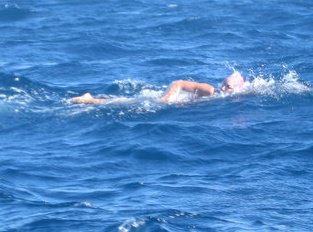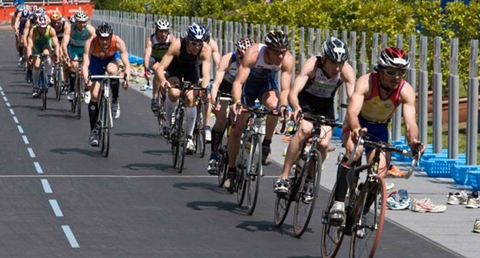Ocean Swimming is a Challenging Sport!
"If you want to swim in the ocean, you need to be prepared for what the ocean is going to give you that day."
When I was young and naive and knew a lot less about the ocean, I didn’t think twice about getting in and swimming, alone, in unfamiliar murky water, even in foreign countries where I knew no one. I've come to appreciate that there is a lot to learn about swimming in the ocean safely.
I love open water ocean swimming. The salt water is healing and there is challenge to the many sea conditions we experience. No swim is the same. Open water swimmers build a healthy aerobic endurance and learn to develop an efficient swimming technique and stoke that is also flexible for the different ocean conditions.
Distance Open Water Ocean Swimming Safety Tips
Here a some important safety tips to consider as a beginner and experienced open water ocean swimmer:
1. Swim with a Group. Swim with a group, or at least one other person. Ideally that person will be about the same speed as you so you don’t have to be stressed about swimming fast enough to keep up. Besides the obvious benefit of this, there is a less palpable feeling of swimming beside your training partners that will make you feel more at ease while you’re in the midst of such an enormous body of water. Plus, when you stop to tread water and look around, you’ll have someone to listen when you say, “Wow! Isn’t this great?!?”
2. Become Familiar with the Water you Swim. Swim in water you ‘know’ or are familiar with. If you are new to ocean swimming, ask around about where the best places are to swim. Local swimmers will know. Ideally the best places to ocean swim will have sandy beaches that make it easy to enter/exit the water, and won’t be known for their strong currents and/or surf. Sometimes the time of year makes a huge difference. Here on Oahu we wouldn’t even think of swimming on the North Shore during the winter because of the world famous surf, but in the summer, it’s typically like a clear calm lake up there and the swimming is the best on the island!
3. Swim within your Endurance Ability. If you’re not confident in your swimming ability, be sure to swim only in lifeguarded areas, and stay out of the ocean completely until you can swim at least 800 meters non-stop and comfortably in a pool. There are no walls in the ocean and in all likelihood it’ll be too deep to stand up, so the only ‘rest’ you’ll get while you’re out there will involve treading water or floating on your back. If you can find one, a kayaker would be great to have along while you’re adjusting to the feel of the ocean.
4. Know about Potential Dangerous Sea Life. It is important to be aware of potentially harmful sea life in your swimming area such as sharks, Orca Whales and jelly fish. Some jellyfish infestations are predictable, like the box jellies that invade Oahu’s south shores about 10-12 days after each full moon. If there are signs on the beach that say, “Warning! Jellyfish!” you might want to find another beach to swim from or just skip it altogether for a few days until they make their way out to sea again. If you’re desperate to swim on a jellyfish day, do it mid-day when the sun is warmest (but wear sunscreen!). Box jellyfish tend to want to be where the water is cooler so as the sun heats the surface of the water, they sink lower. If you’re swimming at a beach known for Portuguese Man-o-War, know that they typically get blown in with the wind, so if it’s a windy day, look carefully on the sand for washed up man-o-wars. If you see some, you might consider skipping your swim that day. Man-o-War tentacles can wrap around you and sting pretty badly. I’ve never known anyone who has been hospitalized by a man-o-war sting, but I’ve personally had some pretty bad ones and they are not fun. It can feel like an electric shock through your whole body and then you’ll end up with itchy welts that can last for several days.
5. Safely Enter the Water. If you’re a confident ocean swimmer, it can be quite fun to swim where there are some waves and swells. The trick to getting into the water is timing your entry right with the shore break. Your best bet is to wait until a white water wave breaks on the sand, then run into the water and dive in as soon as it’s deep enough to do so. Typically, once you’re past the shore break you wont have too many more issues. Though you should be aware that when there is a swell, waves will break when they hit a shallower ocean floor, which isn’t always near the shore. So pay attention to where you see white water waves breaking and know that there will likely be some shallow reef right there. If you’re not interested in getting toppled by the wave or washed up on shallow reef, avoid that area all together. But if you’re up for a little adventure, swim right through it and duck dive under as the wave is breaking (be careful that it’s not too shallow to do this!). Better yet, take a little break from the swim and body surf! Getting out of the ocean where there is shore break can also be a bit tricky. Your best bet is to let a wave carry you in. As the waves are retreating back into the ocean, it can be useless to try to fight against them. Just let them take you out a bit and know that in about ten seconds another wave will come escort you to shore. Let it!
6. Know your Surroundings and Landmarks. Make note of your surroundings and pick something big that will not move for your siting. Mountain peaks, tree lines, pink buildings, and churches with big steeples all make for good siting when you’re ocean swimming. Sometimes swells can get quite large if you’re out far enough and in those cases you might have a hard time seeing anything other than something very large on shore. Also, in most conditions, it's best to complete your swim before the sun sets and certainly before dark!
7. Know the Tides and Currents. Tides have a key impact on ocean swimming conditions. It is valuable to know the local tides for your swimming area. Weather can also impact currents as a strong strom far out to sea can cause unusually strong currents long distances away. .
8. Know the Weather, Weather Patterns, Fog and Winds. As weather conditions play an important role in sea conditions, it is a good idea to know the weather forecast. It is also valuable to learn local typical weather patterns. Winds and fog can be more typical during certain seasons and or during certain times of the day. When it’s windy, if you’re swimming in the ocean, you’re likely going to be swimming through wind chop. When I first moved to Hawaii and started ocean swimming regularly, I found myself quite annoyed that I had to change up my stroke (shorten it) to battle choppy waters. I would get irritated as I would try to breathe but instead got smacked in the face by white water wind chop. I remember specifically one afternoon, about a mile off the coast of Waikiki, complaining to my swim partner about the chop. I was just OVER IT and irritated that I couldn’t just relax and swim. Instead of consoling me, he laughed at me and said, “Then go swim in a pool.” And he was right. Time to stop complaining. I took a look around, at the Waikiki sky line and Diamond Head in the background, fish under my feet and the challenge of the chop and current. That was a defining moment in my ocean swimming career. At that instant I changed my outlook on the conditions and began to embrace them. Bring on the chop! I can swim through it. Learn to relax and enjoy the conditions rather than fight them.
9. Have a Kayak Guide. Whenever possible, it is a good idea to have a kayaker accompany your open water ocean swims. This is particularly important during more rough weather and sea conditions or when taking on a longer distance than usual.
10. Improve and Adjust Technique to Conditions. Open water swimming involves improving and adjusting your swimming technique that best suits the weather and water conditions. To conserve energy and increase speed, ocean swimming teaches us to adjust our swimming technique to become as efficicient as possible in all conditions. Sometimes, the toughest of conditions forces us to utilize our best and most efficient swim technique.
11. Wear a Wetsuit. When swimming in cooler waters or when swimming long distances, it is important to wear a wetsuit to preserve healthy core body temperature. Although swimming, like other aerobic sports, generates internal heat through increased metabolism, being in the water can relatively quickly deplete our body of heat and lower our core body temperature. This is particularly true in cool or cold water and also true when being in the water for a long period of time. Our body's muscle mechanics begin to become impaired as our core body temperature drops. Wetsuits help maintain core body temperature. Also, as we lose much body heat from our heads, wearing a swim cap helps maintain core body temperature in cool waters. Wearing 2 swim caps instead of only 1 goes a long way to preserving body heat. We begin wearing 2 swim caps even before the water is cold enough to require a wetsuit.
Michelle Simmons is an endurance and Ironman Triathlon Coach in Kaneohe, Hawaii with over 15 years of triathlon racing and training experience. Michelle has a BAE from Arizona State University and is an ITCA Certified Triathlon Coach and is USAT Level 1 Certified. Michelle has competed in the 2010 Rev3 Cedar Point Half (won age group), 2010 Ironman Hawaii 70.3, 2009 Ironman Hawaii World Championships, the 2009 Ironman Lake Stevens 70.3 (2nd in age group), the 2009 Waikiki Double Roughwater 7k Ocean Swim (1st in age group), the 2007 Ironman Hawaii World Championships and other cycling, swimming and triathlon events.





